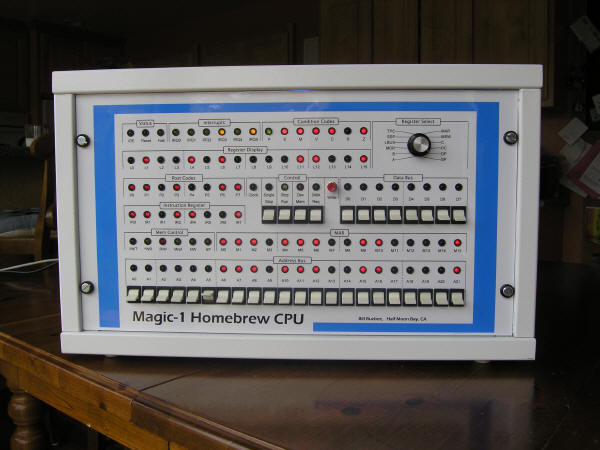又被老外冲击了
来源:互联网 发布:贪吃蛇大作战 源码 编辑:程序博客网 时间:2024/04/28 15:14
在他的主页上还发现了好多他自己小制作,不由得感叹老外的实际动手能力。
更让我震撼的是这个老外本科竟然是新闻专业。。。
在国外,这样的例子太多了,感觉好多老外都是性情中人,他们不带有功利色彩,完全沉醉在自己的兴趣中,将那份爱好发挥到极致。反观国内,太急功近利了。为了DIY这个CPU,Bill Buzbee用了将近五年的时间,试问我们自己又有多少人可以做到这样呢?
好好反思一下,加油吧!
附上Bill Buzbee在自己主页上的介绍:
![]()
 Magic
Magic
In the summer of 1980 I celebrated my freshly minted B.S. in Journalism by blowing most of the cash I collected in graduation gifts on a TRS-80 Model 1 computer. Sitting on the floor of my apartment I fired it up, typed in the sample BASIC program and then "RUN".
WHAT IS YOUR NAME?
"BILL", I responded.
HI BILL
Wow! I was blown away. This was just a machine, but I could interact with it using language that we both understood. As a Liberal Arts graduate with next to no technical background, I found this completely astonishing. Over the next year, I continued to play with my TRS-80 Model 1 while working as a journalist on a small-town Kansas newspaper. I decided that I really wanted to learn more about how computers worked, so I went back to college and picked up a M.S. in Computer Science.
More than 20 years later, I found myself with an urge to touch that magic again by building my own computer from scratch. By "scratch", I meant designing my own instruction set, wire-wrapping a CPU out of a pile of 74 series TTL devices and writing (or porting) my own assembler, compiler, linker, text editor and operating system.
I'm calling this computer the "Magic-1", or M-1 for short. It's a one-address, microprogrammed machine with one-byte opcodes. It features 8/16-bit data operations, functioning on an 8-bit wide data bus with 16-bit addresses (mapped via 2K-byte pages into a 22-bit physical address space). Code and data address spaces can be shared or disjoint, giving each process up to 128K bytes of addressing. User and supervisor modes exist, along with hardware address translation, memory-mapped IO, and support for DMA and externally-generated interrupts. As far as components go, it is built entirely out of 74LS and 74F-series TTL devices plus modern SRAM and EPROMs for the microcode store. After redesigning the memory access mechanism several years into the project, Magic-1 runs at 4.09 Mhz.
Goals
OK, so I understand wanting to do your own CPU, buy why on earth are you doing it this way? I mean, why TTL - why not FPGA? And really, 16-bit virtual addresses in a 22-bit physical address space! What's the deal with that?
I guess any project should start off with some notion what of what you're trying to achieve. My high-level project goals were:
At the end of the day, I wanted a working, and useful, machine that I understood completely. Oh, and it had to have a real front panel with lots and lots of cool blinky lights.
- 又被老外冲击了
- 老外又为了是否使用Spring吵了一天
- 老外又为了是否使用Spring吵了一天
- 老外又为了是否使用Spring吵了一天
- 老外又为了是否使用Spring吵了一天
- 老外又为了是否使用Spring吵了一天
- 老外又为了是否使用Spring吵了一天
- 老外又为了是否使用Spring吵了一天
- 老外又为了是否使用Spring吵了一天
- 老外又为了是否使用Spring吵了一天
- 老外又为了是否使用Spring吵了一天
- 老外又为了是否使用Spring吵了一天
- 老外又为了是否使用Spring吵了一天
- 老外又为了是否使用Spring吵了一天
- 老外又为了是否使用Spring吵了一天
- 老外又为了是否使用Spring吵了一天
- 老外又为了是否使用Spring吵了一天
- 老外被中国app惊呆了
- 这下终于可以方便地发表测试型网页代码了(付源码下载)
- 终于找到了下载下载eclispe源代码的方法了
- 消息循环重载
- ultrawebgrid英文使用指南
- ultrawebgrid所有javascript的function列表
- 又被老外冲击了
- 启动个人物理强化计划...
- 数据库设计过程(续1)
- 新年伊始,大盘继续回暖
- 福布斯公布2007年度十大最热销游戏(组图)
- 破窗理论
- 今天开始学习SIP协议,希望在2个月内将SIP软终端搞出来!!
- 马太效应
- 各种计算机教学录像


